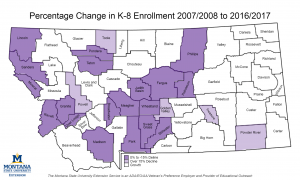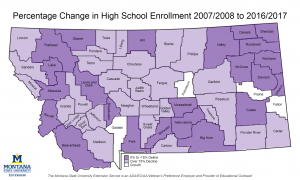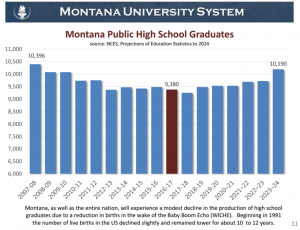Montana has 171 public high schools and even more elementary schools. Over my past few posts, I have highlighted some of the trends that are occurring in Montana with a focus on how Urban and Rural areas are either similar or different. We can use that same lens to explore public school enrollment over the past decade. Although Montana’s population grew by 6.5% from 2008 to 2017, the number of high school students enrolled in declined by about 8% (3,750 students). This is primarily due to demographics of the population and not changes in dropout rates or private high school enrollment. The maps below show the county by county change in both k-8 public school enrollment and public high school enrollment.


A few points of interest, in 2008 the 14 high schools that are classified as “AA” for MHSA sports had a combined enrollment of 20,738 or about 46% of all high school students. The same 14 high schools in 2017 has enrollment of 20,304 or about 49% to all public high school students. Belgrade high school is likely to join the ranks of “AA” schools in the next few years. Once this happens over 50% students will be enrolled in just 15 of the 171 public high schools in Montana.
Another way to look at this data, is to look at the 30 largest and 30 smallest high schools in the state. In 2008, 29,602 students (65.7%) were enrolled in one of the 30 largest high schools. By 2017, 28,242 (68.4%) students were enrolled in the largest 30 schools. On the other end of the spectrum the smallest 30 high schools had total enrollment of 860 students or 1.9% of the students in 2008. By 2017, the enrollment at the smallest 30 high schools has slipped to 555 or (1.3%) of the total. On average the largest high schools lost less than 5% of their enrollment while the smallest schools lost over 30%.
A recent presentation to the Montana Board of Regents projects that the roughly 10 year decline in the number of high school graduates will end in the spring of 2018. Modest increases will occur over the next 5-7 years. This may help school enrollment declines to reverse in some areas and add additional capacity issues to areas that have been growing.

The next decade will likely bring increased k-12 enrollment in Montana. Demographic trends (such as the echoes of the baby boom) and continued overall projected population increases should both support an increase in overall enrollment. The real question will be where will those students be located?

